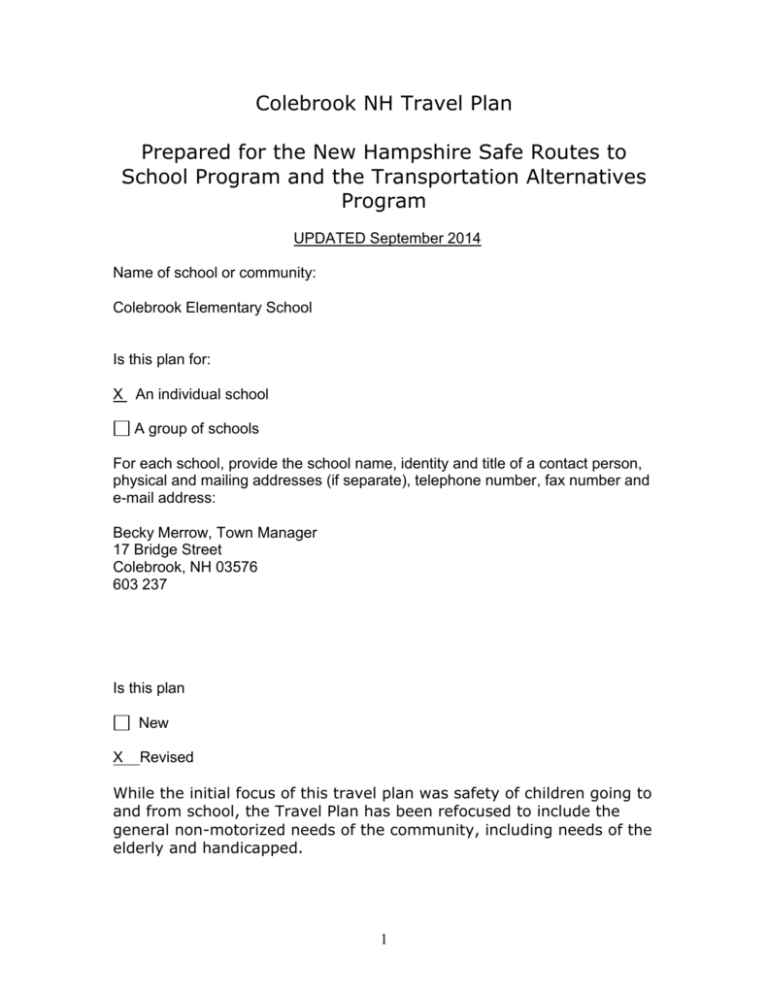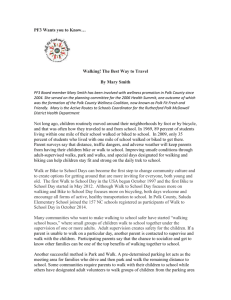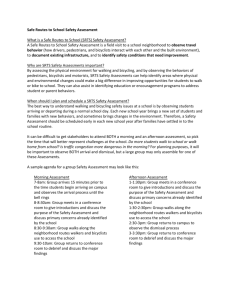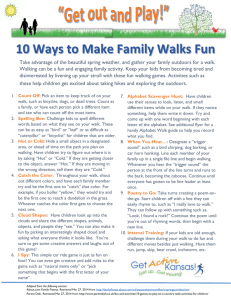New Hampshire Safe Routes to School
advertisement

Colebrook NH Travel Plan Prepared for the New Hampshire Safe Routes to School Program and the Transportation Alternatives Program UPDATED September 2014 Name of school or community: Colebrook Elementary School Is this plan for: X An individual school A group of schools For each school, provide the school name, identity and title of a contact person, physical and mailing addresses (if separate), telephone number, fax number and e-mail address: Becky Merrow, Town Manager 17 Bridge Street Colebrook, NH 03576 603 237 Is this plan New X Revised While the initial focus of this travel plan was safety of children going to and from school, the Travel Plan has been refocused to include the general non-motorized needs of the community, including needs of the elderly and handicapped. 1 On this and the following pages, provide a detailed description of plans to encourage safe walking and bicycling to school. If the plan is being developed in conjunction with an application for SRTS reimbursement funding, fully describe all programs and projects. Rank them in order of local priority and indicate which expenses the community is seeking reimbursement for. Include the cost estimate in the application form. You are not limited by the pages in this document. Add sheets as necessary, but ensure that each page is numbered. Comprehensive List of Identified Streets with Infrastructure or Safety Needs: Including recommendations for improvement #1 PRIORITIZED: Main Street/US Route 3 Improvements Transportation Alternative Program 2015 SEE MAP Sidewalks from the location of Northern Outlet at 61 Main Street (Intersection of South Main Street) to Beaver Brook 163 Main Street (Robert Lemieux or Ducret’s Sporting Goods). Project involves 1920 feet of bituminous sidewalk as well as 970 feet of concrete sidewalk and curving. Sidewalks are not ADA compliant. There are no “traffic calming” devices such as “bump-outs” at key intersections. Crosswalks are not properly aligned. Retro-reflective signage is not present. A new bicycle lane in the downtown area is proposed. These infrastructure improvements would leverage existing plans to construct a Appalachian Mountain Club (AMC) “Riverwalk.” This Riverwalk plan has been submitted to the Northern Borders Regional Commission and is a partnership with the Colebrook Downtown Development Association and the Town of Colebrook. The Riverwalk is a stand-alone local project but the improvements listed in this plan would link the Riverwalk and the Downtown, thereby greatly increasing the communities access to non-motorized pedestrian trails and infrastructure. This is the “high traffic” area of downtown. It involves non-motorized pedestrian and bicycle traffic from the elementary school, to the library, high school and recreation center. While the initial focus of this travel plan was safety of children going to and from school, the 2 Travel Plan has been refocused to include the general non-motorized needs of the community. The sidewalks in downtown Colebrook are not ADA compliant. During a recent water income survey of 600 households in downtown Colebrook, we learned that 13.95% of the households surveyed (65 people) identified themselves as handicapped and 167 people or 35.85% of people identified themselves as elderly. Clearly, an emphasis on safe ADA compliant walking paths and sidewalks is needed for the entire community. It is extremely stressful for an elderly or handicapped client to navigate the presently existing sidewalks and crosswalks to receive necessary services at the Vershire Center, for example. Northern Health & Human Services, including Vershire and The Haven assists people affected by mental illness, developmental disabilities and related disorders in living meaningful lives. In 2013, they served over 60 people individuals in the geographic area. They have been in existence for over 30 years and employ over 50 community members. Other areas that need improvement for elderly and handicapped clients are access to the library, recreation center, library, clinic and hospital. It includes the West side of Main Street Detailed Cost Estimate enclosed. $795,500 including mobilization, right-of-way, permitting (historical and final environmental), safety/ pedestrian lighting, re-design of key gateway sign and construction administration. Estimates do not include contingencies or retainage. 100% performance and construction bonds with contractually mandated liquidated damages will be required. Other/Lesser Priorities: Possible sidewalk from fire lane (right behind school coming out by music rooms) Titus Hill (lower section to fork) Spring Street (right of way may be too small – check) High Street (plus enforcement speed issues) 3 Request blinking speed sign be in use on High Street and Spring Street at the first few weeks of school Pleasant Street – curbing by First Run and Bridge Monadnock Street – curbing Colby Street by Lewis Ford North Main Street from Merrill to Couture Street Park Street – to Route 3; Head Start Corliss Lane – new sidewalk with drainage; 3800 feet. Cost prohibitive. South Main Street Merrill Street – Right-of-Way too small? Check Bridge Street – both sides. Improvements here could be handled locally with new sidewalk paving machine. Asphalt at $100/ton Snack Shack Road –Colby Common Access and Vershire Access Main Street in front of Kiwanis Park The Colebrook Safe Routes to School Task Force created this detailed Travel Plan. Travel conditions in Colebrook are not complicated. Walking and bicycling routes are known by the school staff and the police department. With only one K-8 elementary school in the downtown, the task force felt that they were the proper group to prepare this plan. The Colebrook Safe Routes to School Task Force is diverse and has been meeting since September, 2012 to develop this Travel Plan, to prioritize infrastructure projects and to develop a comprehensive program to encourage children to walk or ride their bicycles to school. The Task Force is listed below: Name Lisa Kenney Melissa Shaw Kevin McKinnon Affiliation Colebrook Elementary School Teacher Colebrook Recreation Director Public Works Director 4 Becky Merrow Raymond Gorman Paula Fletcher Debby Dionne Denis & Pauline Finkell Michelle Schafer Ralph Fogg Greg Placy Robert Mills Stephen Cass Cheryl Covill Mary Jolles Joanne Melanson Colebrook Town Manager Colebrook Selectman Reverend Colebrook Elementary School Teacher Parents Littleton Parent and Littleton SRTS Coordinator Citizen School Board Chair and former DOT Engineer School Superintendent Chief of Police SAU Administrative Assistant Colebrook Elementary Principal Colebrook Academy (High School) The Colebrook Safe Routes to School program involves the 5 E’s. Our Mascot’s—Murphy and Molly—two adorable stuffed moose, will lead children on a year long discovery of the benefits of walking and bicycling to school. They will lead a walking school bus beginning on the first day of school. Each Wednesday thereafter, running for six (6) weeks they will lead another walking school bus. The program will discontinue during the extreme winter months and will resume in spring. Children who participate will receive incentives. Additional incentives will be given to children who walk additional days during the week. The objective is to start children out on the first day of the week walking or bicycling to school in hopes that they will voluntarily do more walking later in the week. Education and outreach for the program will include a Facebook page and information about the program on the Towns webpage. The Colebrook Recreation Department will support the program and will assist with activities to further a connection with walkers and bicyclists and to generally promote physical fitness and activity. A main emphasis in the educational component of the program is to help parents make a “home to school” connection. As children leave from home, walking to school with parents, other classmates and Molly and Murphy, they will arrive at school refreshed and ready to study. The two locations for walking will begin at the Colebrook Country Club and the North Country Recreation Center. It is hoped that exposure to the golf course and recreation center will begin discussions about other ways in which to introduce physical fitness into children’s life. In addition to the walking school bus, the Kiwanis Club hosts an annual bicycle rodeo. Murphy and Molly will be in attendance. During this 5 time of heightened awareness of safety issues involved in walking or bicycling to school, the police department will increase enforcement activities by having a speed trailer available. They will aggressively ticket speeders. Please find below a listing of the entire infrastructure needs the SRTS Task Force analyzed within the two mile radius of the school: Prioritized safety listing within existing funding: (Projects Colebrook would seek funding for— **Cost estimates attached separately) 1. Kiwanis Park. Front entrance to the school with crosswalk and crossing guard. Children walk on grass or in the school parking lot entrance. Safety concern. Parental survey’s, discussion with Public Works Director, School Board and SRTS Task Force all agree that this is a significant barrier to children walking to school. 2. Sidewalk in main school parking lot. The great amount of traffic when school convenes and lets out makes this an important safety improvement. 2012 Cost estimates attached. Community organizing efforts: Briefly summarize efforts to both create a SRTS task force and to build community support for a local program. A SRTS task force has been formed, is meeting, and is active in this project. Press releases were sent out and interviews were given to local newspapers. Radio “spots” were given—we reached a parent as far away as Littleton! A broad cross-section of parents, grandparents, citizens, educators, and community leaders is represented on the task force. Two articles in the School newsletter about the SRTS program have gone home to parents to begin the “home to school” connection. Ongoing community support will include creation of a webpage for our mascots, Murphy and Molly (two adorable stuffed moose). a) Attach documentation of support from governing bodies (Include letters of support from school and/or municipal body (or designee) with authority to enter into a formal agreement (school board, city council, board of aldermen, board of selectmen). Include documentation of local commitment to maintain any infrastructure. 6 See attached letter of support from Selectmen with commitment to maintain. b) Attach documentation (letters or survey results) of parental support See attached summary of survey results. c) Attach any letters of support from representatives of the educational community. See attached letter of support from Lisa Kenny, Teacher. See attached letter of support from Bob Mills, School Superintendent. d) Attach any letters of support from walking and bicycling organizations and other interested advocacy groups. See attached letter of support from Police Chief, Stephen Cass. See attached letter of support from Judy Houghton, President of Kiwanis Club. See attached letter of support from Charles Cotton, Director of Northern Human Services. See attached letter of support from Trinity United Methodist Church. In addition to providing safe walking routes for children going to school, the travel route has a social service organization on it. This organization provides support to people with mental and physical disabilities. An ADA compliant sidewalk will be helpful for people in wheelchairs who utilize this route. 7 Mapping: Submit a map or maps showing a radius of approximately two miles around each school. Show residential neighborhoods and indicate the approximate number of students in kindergarten through 8th grade in each neighborhood. The map or maps should also display existing and proposed safe routes for bicycling and/or walking between residential neighborhoods and schools. See attached map of downtown Colebrook indicating streets analyzed by the Safe Routes to School Committee within 1 and 2 miles of the school. See attached map of neighborhoods and existing travel routes (walking) to school. 8 Evaluation: Summarize the results of the in-class and parent surveys and any walkability and/or bikability surveys. (Submission of the community’s data in the report developed by the National Center for Safe Routes to School meets this requirement.) Distance from the school (greater than 2 miles) is too great. Many children already walk! Edwards Street and Main Street Bridge Street and Main Street Park Street and Merrill Street Main Street and Parson Street Relocate the existing bicycle rack Poor weather – create “warming places” on the identified route(s) Plow sidewalks as often as possible Supervision! Risk of harm from pedophiles – walking school bus lead by recreation staff and guest walkers Safety precautions such as speeders and amount of traffic too great Lack of sidewalk on Dumont Street! Children walk in road. Travel time too great Preference for bus Age of children – too young to walk Describe the existing participation of students walking and bicycling to school and the potential for increasing this participation if barriers (physical, cultural and otherwise) are removed. Colebrook has many children who walk. It is estimated that 25-35 children already walk each day. Definitely correcting safety concerns, particularly on Dumont Street (rear entrance to school) and Main Street (primary entrance to the school) will increase walking participation. Parental surveys echo this sentiment of the SRTS Task Force. If the community has a master plan that includes proposals for enhancing walking and/or bicycling, submit a copy of the relevant sections. In addition, include a description of any efforts to maintain or enhance compact settlement patterns that use land, resources and infrastructure investments efficiently. The evaluation process will identify barriers to safe walking and bicycling from home to school and document the effectiveness of SRTS programs. 9 A number of years ago, when the voters approved an elementary school addition, they considered whether or not to relocate the school outside the downtown district. The voters did not support relocation of the school. Instead, they informally agreed that after the bond for the new addition was paid off, they wanted the high school to be added to the elementary school. This documents the efforts of the local citizens to keep compact settlement patterns and to avoid sprawl. If this “phase two” incorporation of the high school takes place, it is even more important that safety investments be made for walking to school as we could easily double the number of children walking to school. 10 Encouragement Describe plans for events such as walking school buses, rolling bike trains, walkto-school days, school assemblies, walking clubs etc. Beginning on the first day of school, Molly and Murphy, our Moose Mascots, will lead a walking school bus with the children. On every Monday, our Mascots will also lead a walking school bus. Children will receive incentives for walking. Our Mascots will participate in the October annual “walk to school” day. An assembly will “kick start” the program so that children can learn about the program. A Facebook page will be set up so that parents can learn about the program at home and make a “home to school” connection of the program. A link about the program and the Colebrook Recreation Department’s involvement will be created. Education Describe bicycle and pedestrian safety courses, bike rodeos, efforts to educate motorists, etc. Two articles about the benefits of walking to school have already been published in the school newsletter. This was distributed to all of the parents at the elementary school. Radio and newspaper has been utilized to inform the public about the program and formation of the task force. Many meetings have taken place to identify the travel plan, define existing barriers and to prioritize infrastructure projects within a reasonable budget. The Kiwanis Club, in conjunction with the police department, holds an annual bicycle rodeo. In the past, participants have received a free bicycle helmet! Motorists will be warned in the newspapers that speeding on the travel route will be taken very serious and will result in tickets—not just warnings. 11 Enforcement Identify efforts by police, crossing guards and others to prevent speeding, failure to stop in crosswalks, etc. During the “kick off” meeting, crossing guards will be invited as will the police. A comprehensive enforcement initiative will take place. A “zero tolerance” speed enforcement will take place. A speed trailer will be set up by the police department in the week prior to the opening of school to reinforce this zero tolerance approach. Engineering Describe physical changes to make walking and/or bicycling from home to school safe and inviting. Examples include sidewalks, bike routes and paths, signs and pavement markings, intersection improvements and traffic calming projects. New sidewalks on Dumont Street, on Main Street at Kiwanis Park and in the rear school parking lot will greatly improve safety concerns of parents and the SRTS Task Force. Funds have been included in the SRTS Grant application for improved cross walks, increased traffic signs (with retroreflectivity improvements) and pavement markings to clearly identify the travel route within the 2 mile radius of the school. UNDERWAY: (UPDATED) Dumont Street Asphalt with granite curb on Dumont (Awarded a Safe Routes to School Grant with anticipated groundbreaking spring 2015) Extend sidewalk from Dumont Street to rear school sidewalk (Awarded a Safe Routes to School Grant with anticipated groundbreaking spring 2015) 3. Dumont Street. Main walking route to the school. Lots of school traffic—children often walking in the street. Parental survey’s, discussion with Public Works Director, School Board 12 and SRTS Task Force all agree that this is the number 1 barrier to children walking to school. Engineer and construct “path” from Main Street entrance to back parking lot on school property 13







